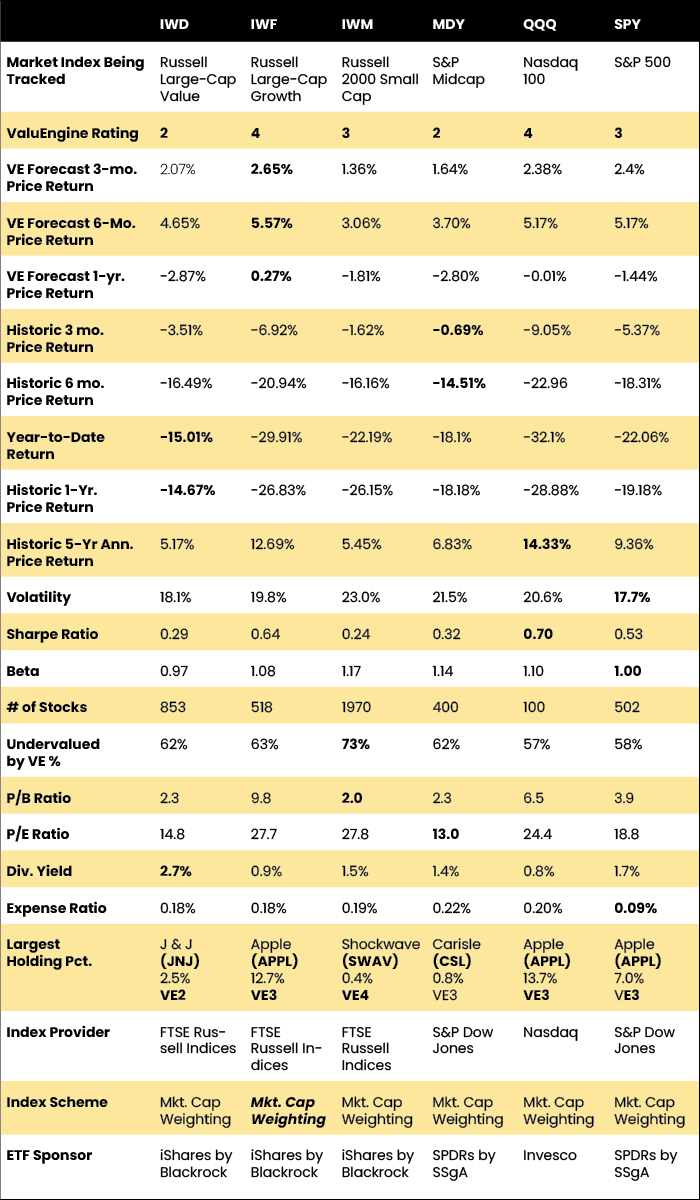The third quarter of 2022 was truly “a tale of two eighths.” It was a clean dichotomy. The market staged what turned out to be a bear market rally throughout July and the first two weeks of August. Then it was as if somebody blew a whistle. The next six weeks saw the bear return with a vengeance. The question now is whether the market is oversold and ready for a rebound in the November through mid-April period that is traditionally stronger for stocks.
On a quarterly basis, I provide analysis focusing in the ETF reports on ValuEngine that follow market benchmarks. The data on these funds provide a side benefit in writing market analyses for each major U.S. equity market segment. They are windows to implicit forecasts for three-, six- and 12-month forecasts VE models are making for each broad and specialty benchmark’s ETF portfolio. The ratings and projections combine bottom-up constituent analysis with analyses of the historical price movements of the ETF in different market environments.
Benchmark indexes and ETFs
The benchmark indexes and ETFs chosen for this feature are:
- The S&P 500 Index representing U.S. large-cap stocks, the ETF is iShares’ SPY.
- The S&P MidCap 400 Index representing U.S. mid-cap stocks; the ETF is SPDR’s MDY.
- The Russell 2000 Index representing U.S. small-cap stocks; the ETF is iShares’ IWM.
- The Russell 1000 Large Cap Growth Index; the ETF is iShares’ IWF.
- The Russell 1000 Large Cap Value Index; the ETF is iShares’ IWD.
- The Nasdaq-100, constructed as an index using the top 100 non-financial stocks with primary listing on the Nasdaq, but now regarded as the premier U.S. big tech index; the ETF is Invesco QQQ.

Somewhat surprisingly, small-cap stocks and mid-cap stocks as represented by their respective ETFs held up better during the quarter than the four indexes representing various segments of large-cap stocks. The ETF for small-cap stocks, IWM, was also the most robust during the rally period and held onto more of its gains during the August 15 to September 30 market collapse than any of the other five ETFs to register the smallest loss for the quarter.
In contrast, large-cap value stocks, as measured by IWD, lagged the other five ETFs by quite a bit during the July through mid-August rally. Thus, even though IWD had the least severe loss during the rest of the third quarter, it wound up as the biggest loser for the full quarter.
On balance, large-cap value was not the place to be during the third quarter of 2022. Similarly, even though QQQ suffered the worst carnage in the second half of the third quarter, the fact that it had previously led the group on the way up resulted in a lower decline in the third quarter for QQQ than SPY.
That’s what happened in the third quarter. What could happen next? For pondering that question, let’s look to the data summary table below. All data are as of Oct. 14, 2022.

A look at the VE models
In order to frame our forecasts, let’s look at the ValuEngine ranking summarizing our models’ views on the expected price appreciation of SPY, the SPDR (“spider”) based on the S&P 500 Index. Given its bellwether status as the market’s proxy, a rating of 3 (neutral) is the norm for SPY. The ValuEngine market forecasts for SPY – and thus the S&P 500 – will vary from negative to positive depending on our models’ assessments of the current environment.
Focusing on the S&P 500 column in the three rows containing our forecasts, our models expect the market to navigate the next three to six months in positive territory. After that, however, between mid-April and mid-October of 2023, our models forecast that the S&P 500 will relinquish those price gains and a bit more.
Are there segments of the market for which the ValuEngine models have a more positive outlook? Yes, the two large-cap growth-oriented ETFs, Russell Large Cap Growth, IWF, and Nasdaq-100, QQQ, both get ValuEngine’s second-highest rating of 4 (attractive) for upcoming performance. Of the two, IWF gets our highest forecast targets across the board and is the only one of the six benchmark ETFs to have a positive forecast target for one-year-ahead performance.
In contrast, the S&P MidCap ETF, MDY, held up best during the past three-month and six-month declines but is not expected to perform as well as the other benchmark ETFs going forward. Its rating is 2 (below average) and its return targets for the next three-, six-, and 12-month periods are our second lowest across the board. IWD, the Russell 1000 Value ETF, is also rated 2 and receives our lowest return targets.
On a valuation basis, the small-cap segment ETF, IWM, looks unusually attractive on a price-to-book ratio basis. It also has the highest percentage of undervalued companies, 73%, according to our valuation models. Moreover, three of the stocks in its top 10 weightings are rated 4 (attractive) by ValuEngine. These include Shockwave Medical (SWAV), Chart Industries (GTLS), and Karuna Therapeutic (KRTX).
In general, a little over 62% of ValuEngine stocks are deemed undervalued by our valuation model as compared with just below 40% at the beginning of the year. Therefore a 22% decline in SPY has been enough to transform a market with more than 60% overvalued to one that has the same proportion of stock now undervalued relative to intrinsic value.
This can be thought of as analogous from a market being overbought to one that is now oversold. This interpretation would be consistent with the positive three- and six-month forecasts for SPY and the other benchmark ETFs. Repeating information I have frequently given in this column, if you decide to buy new shares of an ETF that follows the S&P 500, consider strongly buying VOO from Vanguard rather than SPY.
A higher fee and a less efficient management structure combine to give SPY investors an average of a 0.125% lower rate of return for holding an identical portfolio. If not VOO, our highest-rated ETF, IWF, tracking the large-cap growth market is a fairly equivalent substitute. Its correlation with VOO is about 0.99.
Can investors recapture declines?
Will this optimistic forecast be enough for buy-and-hold investors to recapture a significant percentage of account balance declines already caused by the current bear market? Historically, dating back to 1926, July is the third strongest month for the market and September is the weakest. This year’s numbers followed that history as if they were on steroids.
Although January hasn’t fared particularly well during the past 10 years, in the longer term, it’s been the second best, recently falling a bit behind December. November and March are also good months relative to May, June and September. Our signals have now shifted to being guardedly optimistic for the next six months.
Given the nine-month bear market, here is another fact to consider. Many investors may now be underweighted by more than 10% in equities relative to their strategic allocation. Today may be an opportune time to rebalance, shifting money in alternative asset classes back to stocks. As per usual, only time will tell.
Herb Blank is a senior quantitative analyst at ValuEngine and senior consultant and practice leader in the Global Finesse Product Strategy and Implementations Consulting Practice. He has more than 30 years of experience in financial product innovation and quantitative analysis. Recognized as a pioneer in the exchange-traded fund (ETF) industry, Blank established the first family of ETFs to trade on the NYSE and was a portfolio manager for the fund. He is credited with the product development and launch of iShares, GLD and X Shares. He is also well known for his development of the construction and maintenance methodologies for Dow Jones Global Indexes.







